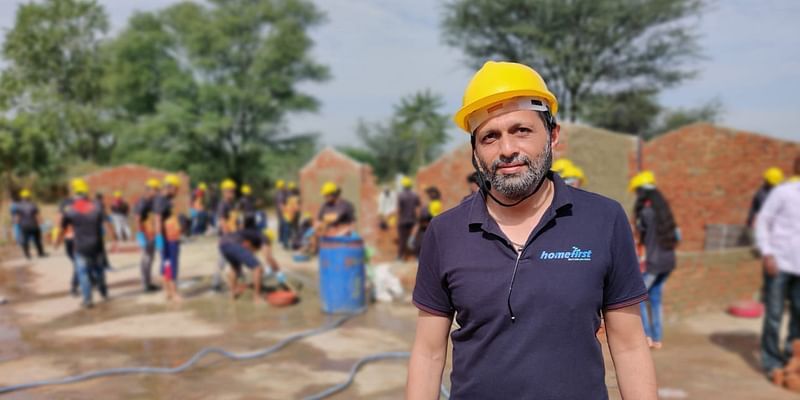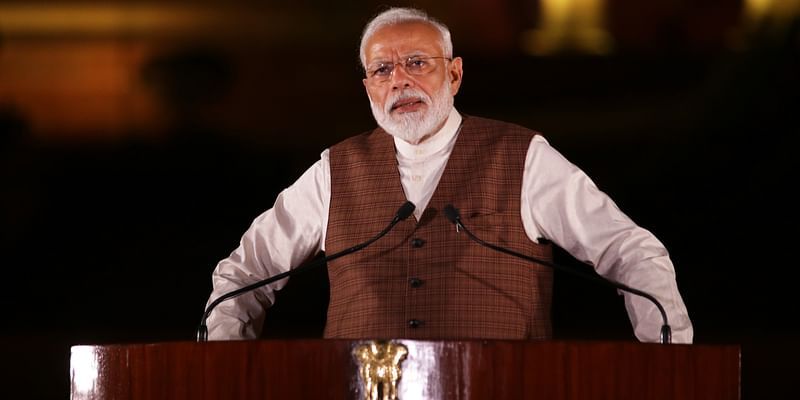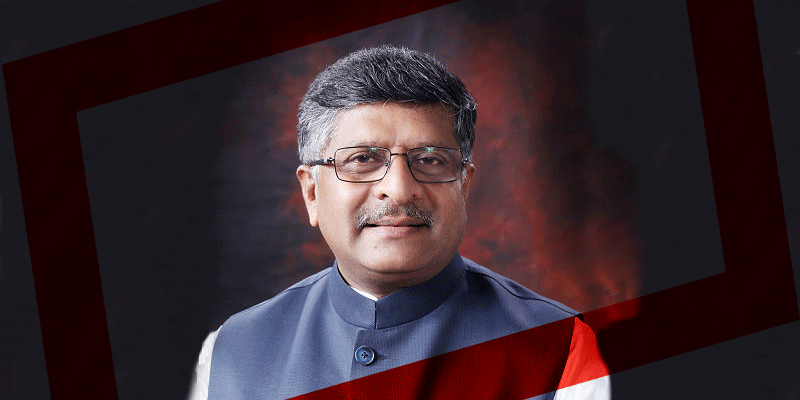This entrepreneur is on a mission to provide affordable home loans to 50k+ low and middle-income families
In 2010, Manoj Viswanathan and his business partners started Home First to make home loans accessible to lower and middle-income families. In FY20, the NSE and BSE-listed company recorded AUM of Rs 3,618 crore with 50,000 customers and 800 employees.
In 2008-09, entrepreneur Manoj Viswanathan was in charge of selling apartments in Bengaluru. Working with Value Budget Housing Corporation (VBHC) with his partners Jaitirth “Jerry” Rao and PS Jayakumar, it was not easy for Manoj to find suitable housing finance providers for potential customers.

Home First team members
The engineering and MBA graduate spoke to several housing finance companies but felt none of them were equipped to provide loans for VBHC’s low-income, informal customer base.
“They were hesitant to finance loans for affordable homes for anyone with low income. Since the three of us came from a financial background, we decided to solve this problem by starting an affordable housing company to help the customer segment left uncatered to by traditional lending services. This was how the idea for Finance was born,” Manoj says.
In 2010, the trio set up Mumbai-headquartered Home First and began making home loans more accessible to lower and middle-income individuals. In ten years, Manoj and his partners have grown Home First into a leading housing finance company.
In FY20, the company claims to have recorded an AUM of Rs 3,618 crore with 50,000 customers and 800 employees. Earlier in 2021, Home First listed on the BSE and NSE in an IPO that was subscribed 26.66 times.
In an exclusive interview with SMBStory, Manoj Viswanathan, MD and CEO, Home First, traces the journey of Home First and explains how it is catering to the underserved segment of affordable home loans.
Edited excerpts from the interview:
SMBStory [SMBS]: How did the three of you come together to start Home First?
Manoj Viswanathan [MV]: Jerry, Jayakumar, and I were linked together from our days at Citibank. When I had made up my mind to quit and venture out on my own, I got together with them to start VBHC as a budget housing company for constructing affordable homes.
We learned early on that traditional banks shied away from lending to low and middle income customers. Over a few coffees, we discussed how a pani puri vendor, kirana owner, or anyone with a cash salary could get a home loan.

Home First MD and CEO Manoj Viswanathan
We realised with our expertise in finance we should get into the supply side of housing loans and make them more accessible. So we set up Home First in 2010.
SMBS: What were the initial challenges you faced? How were they solved?
MV: While our intent was to service the unorganised sector, there was no system to evaluate the credit worthiness of such a customer. The formal channels simply deemed them not creditworthy, and assessing them required to build a new way of evaluation.
Just as every challenge births impetus to a movement, this problem resulted in one of our earliest and most successful campaigns, which we called ‘We see you and not your documents’.
We started a “touch and feel” credit system without a set template. We met with every family personally to understand and evaluate them accurately and tried to come up with a customised solution for them.
SMBS: How does this touch and feel system work?
MV: Our customers are usually from families that earn between Rs 20,000 and Rs 50,000 a month. Here, multiple members in a family may earn small incomes. Only one or two might have a formal income in the form of a salary, while others may earn small salaries in cash.
The major task is assessing their total income. We spend time with the families to understand their total income, which helps us underwrite a housing loan.
SMBS: The touch-and-feel system sounds time-consuming. Tell us how you scaled it.
MV: Traditionally, such a process would entail asking customers to provide physical documents and photocopies, picking up the documents, sending them for processing, and then verifying them.
Home First has been using technology to speed up the entire process. Initially, we used handheld scanners to scan documents. Then, we used smartphones to record discussions with customers and capture their working environment. Everything would be fed into our system.
Now, when our team member goes to a family, he/she simply scans all the documents on a smartphone and it is directly uploaded on our system.
We also validate their information such as GST returns or vehicle registration for example, through online integrations. We are now able to determine a customer’s authenticity quickly.

The Home First team
SMBS: How did you diversify into different home loan categories?
MV: Initially starting off with just home loan, our products have revolved around and grown with our customers’ requirements. The additions of products like Home Construction Loan, Loan Against Property, Home Extension and Renovation Loan, and Shop Loan have helped us become a singular destination for all home loan and shop loan requirements.
We are also able to bring these services to customers through innovations like document scanners and now Data Analytics and Cloud Technology. We believe our investments in technology and a deep belief in digital processes and payment mechanisms are setting us apart.
SMBS: Who are your competitors? Besides your use of technology, how are you staying ahead of the game?
MV: The rest of the world has caught up with the trend of affordable housing to the level that it is now a buzzword in the lending industry. Several lenders like , Aadhar Housing, Gruh Finance Limited, , Shriram Housing, Can Fin, etc., operate in similar segments.
What helps us stay ahead are small things that make a big difference. Our customer-centricity is focused to the point that we ensure doorstep collection from the customer. The customer only needs to meet and talk to one official - a relationship manager, so that there is no hassle in the process.
SMBS: How are you reaching your target customers?
MV: Although our average customers belong to the low- and middle-income segment, they all use smartphones. We use YouTube, Google, and Facebook ads to reach them and help them understand how we can help them build their dream home.
We also regularly provide home decor tips, conduct small contests for customers, and host webinars on social media to explain home loan-related developments and clarify any doubts.
We are also well-connected in the construction community. Builders, contractors, and brokers know us and refer us to customers. For instance, if a contractor is in touch with someone who wants to build a house, they are referred to us.
SMBS: What were the key milestones in the business journey?
MV: Our first office was actually in Bengaluru. A year after we started, we received Series A funding from Bessemer Venture Partners. By 2013, we had approved 1,000 loans, and in 2014, we turned profitable.
As word spread about us, the next big milestone came in 2015 when we on-boarded 5,000 customers. The next year, we doubled our customer base, and in 2017, both ICRA and TrueNorth displayed confidence in us with an A+ rating and Series C funding, respectively.
We have not looked back since. Recent achievements include a Rs 700 crore investment from Warburg Pincus last year, and getting listed on the NSE and BSE this year.
SMBS: What were the toughest moments the company faced?
MV: Since we are focused on a certain type of customers, events affecting the customer also impacts us in a way.
Demonetisation in late 2016 affected the middle and lower middle-income groups adversely. As a result, the liquidity of the entire market and the regular income of our customer segment took a hit.
However, our personal connection with customers along with our investment in technology and digital payment mechanisms helped us pull through the dark times. Recently, the COVID-19 pandemic also disrupted a lot of industries, but our portfolio and customer base displayed resilience and staged a comeback.
Once our customers got back their jobs, the business started to pick up. By December 2020, our metrics were back to pre-COVID levels.
SMBS: What were your thoughts behind going for the public listing? Why now?
MV: Last year, we were looking to get listed. We filed our DRHP in November 2019, and almost got listed in March of 2020. But then the pandemic hit the world and we went into lockdown. The discussion with Warburg started around the same time because we felt we needed a large, global investor to ensure sufficient capital in case the pandemic stretched on.
Then, the market showed positive sentiment over the last few months, and our card was active till March 2021. We were doing well, and our disbursements and collections were improving month-on-month. So this seemed like a good time to go public with an IPO to augment our capital base for meeting future capital requirements.
The total IPO size was Rs 1,153 crore. Rs 265 crore was the primary portion coming to the company. The rest was the secondary portion existing shareholders were selling.
SMBS: What are the future plans for the company?
MV: As more people migrate to cities due to urbanisation and nuclearisation, the affordable housing segment will remain strong. We plan to penetrate further into the market as we feel these families will predominantly prefer to own a house rather than rent it. There is a segment that prefers to rent, but ownership is a stronger phenomenon that will last 20 to 30 years at least.
Edited by Megha Reddy













